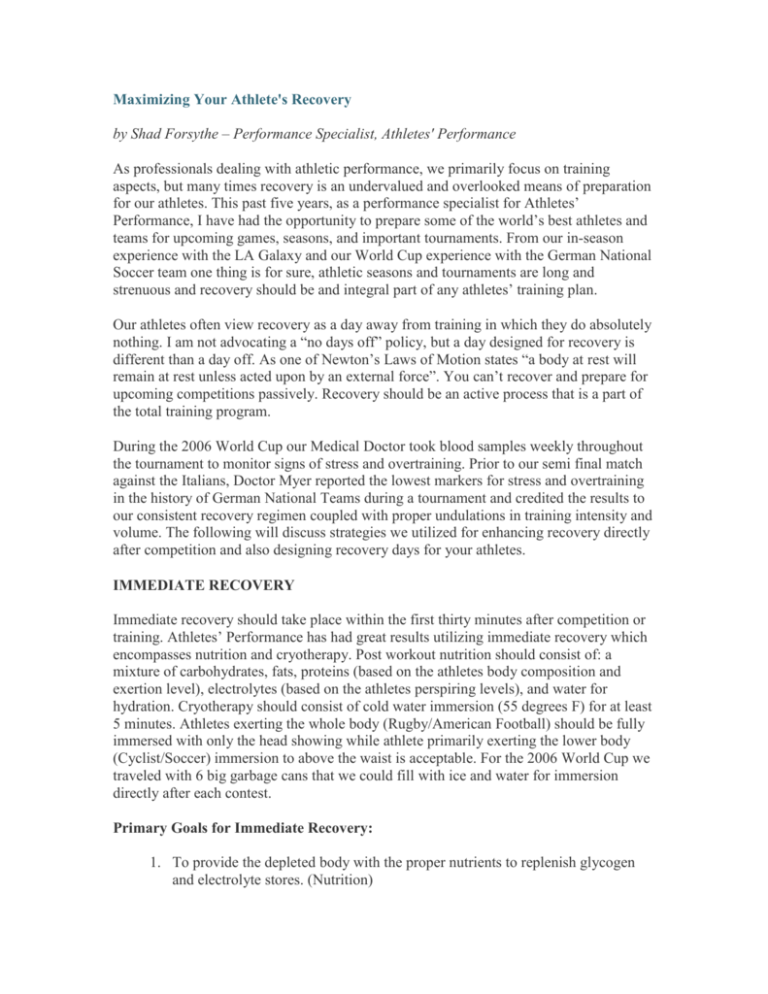Maximizing Your Athlete`s Recovery
advertisement

Maximizing Your Athlete's Recovery by Shad Forsythe – Performance Specialist, Athletes' Performance As professionals dealing with athletic performance, we primarily focus on training aspects, but many times recovery is an undervalued and overlooked means of preparation for our athletes. This past five years, as a performance specialist for Athletes’ Performance, I have had the opportunity to prepare some of the world’s best athletes and teams for upcoming games, seasons, and important tournaments. From our in-season experience with the LA Galaxy and our World Cup experience with the German National Soccer team one thing is for sure, athletic seasons and tournaments are long and strenuous and recovery should be and integral part of any athletes’ training plan. Our athletes often view recovery as a day away from training in which they do absolutely nothing. I am not advocating a “no days off” policy, but a day designed for recovery is different than a day off. As one of Newton’s Laws of Motion states “a body at rest will remain at rest unless acted upon by an external force”. You can’t recover and prepare for upcoming competitions passively. Recovery should be an active process that is a part of the total training program. During the 2006 World Cup our Medical Doctor took blood samples weekly throughout the tournament to monitor signs of stress and overtraining. Prior to our semi final match against the Italians, Doctor Myer reported the lowest markers for stress and overtraining in the history of German National Teams during a tournament and credited the results to our consistent recovery regimen coupled with proper undulations in training intensity and volume. The following will discuss strategies we utilized for enhancing recovery directly after competition and also designing recovery days for your athletes. IMMEDIATE RECOVERY Immediate recovery should take place within the first thirty minutes after competition or training. Athletes’ Performance has had great results utilizing immediate recovery which encompasses nutrition and cryotherapy. Post workout nutrition should consist of: a mixture of carbohydrates, fats, proteins (based on the athletes body composition and exertion level), electrolytes (based on the athletes perspiring levels), and water for hydration. Cryotherapy should consist of cold water immersion (55 degrees F) for at least 5 minutes. Athletes exerting the whole body (Rugby/American Football) should be fully immersed with only the head showing while athlete primarily exerting the lower body (Cyclist/Soccer) immersion to above the waist is acceptable. For the 2006 World Cup we traveled with 6 big garbage cans that we could fill with ice and water for immersion directly after each contest. Primary Goals for Immediate Recovery: 1. To provide the depleted body with the proper nutrients to replenish glycogen and electrolyte stores. (Nutrition) 2. Cooling the body’s core temperature, hydration, and decreasing the production of catabolic hormones. (Nutrition/Cryotherapy) 3. Decreasing secondary hypoxic injury. Micro tears occur throughout muscle tissue and are the primary cause of DOMS (Delayed Onset Muscle Soreness). Cooling the body’s tissue limits the extent of DOMS by decreasing the tissues need for oxygen and thus limiting secondary hypoxic injury to the micro tears. (Cryotherapy) Example: Soccer Player finishes playing a 90 minute match. 1. He immediately has an EAS Myoplex Original Chocolate Shake, 24 oz of Gatorade, and 24 oz of Water. (For an economical option try chocolate milk, a banana, and some water.) 2. He then sits in a cold whirlpool 55 degrees F for 5 minutes. RECOVERY DAY In the planning of your athletes’ weekly calendar, the recovery day should be the day after the contest and the day before the athletes’ day off (if there is one). On this day the main focus should be to enhance the clearing of metabolic waste products from the day before and to return tissues to normal length, tension, and quality. Athletes’ Performance has had great success facilitating recovery by the utilization of these modalities: increasing circulation, utilizing self and/or professional massage and flexibility techniques, and utilizing contrast therapy. Primary Goals of Recovery Day 1. Increase circulation with the use of non-pounding aerobic modalities such as stationary bikes or elliptical trainers to bring oxygen rich blood into the recovering tissues and enhance the removal of metabolic waste products. (Aerobic Flush/Contrast Therapy) 2. Self massage and flexibility utilizing foam rolls from Perform Better or other modalities to assist in returning muscles to normal length, tension, and quality. (Self or Professional Massage/Flexibility) 3. Utilization of cold and hot modalities such as plunges, whirlpools, Jacuzzis, saunas, and steam rooms to stimulate vasoconstriction followed immediately by vasodilatation to enhance circulation of oxygen rich blood and removal of metabolic waste products. (Contrast Therapy) Example: A day after a match that a soccer player has played 90 minutes. 1. 20 minutes aerobic flush, this should be easy with no work on the legs. 2. 20 minute self massage using Perform Better foam rolls and flexibility routine. 3. 2 minutes cold whirlpool 55 degrees F, 3 minutes hot whirlpool 104 degrees F repeated 3 times. Note: if the athlete plans to have a lazy day ending in hot is fine if they plan to be more active have them complete one more cycle of cold. 4. Total Time 55 minutes. Items of Note: 1. The above is the optimal order of modalities for recovery but beneficial results can be achieved using the above modalities in any order. 2. In the grand planning scheme a recovery day may be a good day to utilize upper body strength and power training for those athletes who engage in primarily lower body activities. 3. I recommend a professional massage once a week for professional and elite level athletes during the in-season and high training times of the off season. Recovery is a very important part of any athletes’ training program. Along with immediate recovery and recovery days, different modalities can be utilized daily after training to enhance an Athletes’ Performance. Recovery should not be a weekly thing, but a daily activity. Take ten minutes and stretch after training. Foam Roll your legs after a tough day. Spend 5 minutes in the cold plunge after a weight room session. These strategies take very little time, but can make the difference over the course of a long season or tournament.



